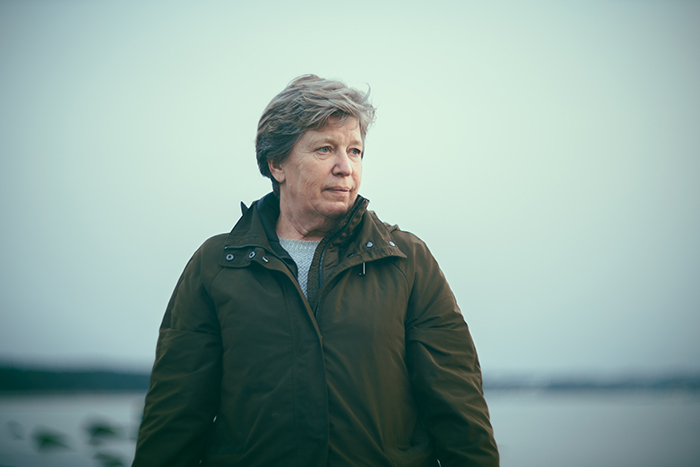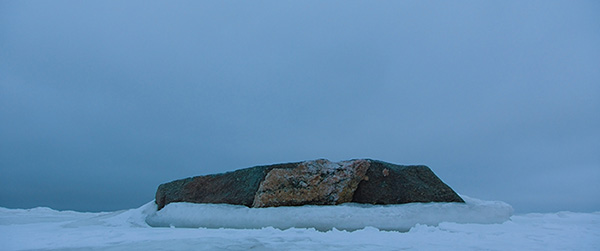|
Kersti Uibo is an independent director of documentary films and a film teacher at the Baltic Film and Media School of Tallinn University. She has taught directing in many countries and her documentaries have been shown internationally. Kersti studied English and German in Moscow, History at London University and Directing at the National Film and Television School in England, the country where she lived and worked for half her life. At the beginning of the nineteen-nineties, she was one of those active London Estonians, who re-established the Estonian Embassy in the U.K. She has travelled extensively in India, Canada, Nepal, Serbia, Kosovo and Russia, making films and gathering inspiration to share with others. She has now returned to her childhood home on the Western coast of the Baltic Sea.
What has been your greatest inspiration since childhood? What is home for you, the place where you long to return?

Kersti Uibo. Foto: Fred-Erik Kerner. I was about 8 or 9 months old, when I first saw the sea and an erratic boulder in the water a short distance from my home. The boulder was a refugee stranded there thousands of years ago. The endless expanse of the ocean must have created such a strong impression on a tiny child that she held on to the shock of such beauty within her and sixty years later an opportunity came to express it in film as an artist. I was asked to make a film about roots at a time when my main concern was rootlessness. As a child, when I looked at the sea and the stone, I felt like a tiny pebble and a wave. For half of my life I had learnt not to put down roots into the soil. Our feet stand on the the earth, but the upper part of our body is already part of the sky and universe. The wind touches your cheeks and invites you to fly. Yet it is impossible to fly away, so you are both rooted and rootless. The stone resembles a human being. Surrounded by the waves and the winds and the storms, even an erratic boulder is displaced. The sense of being at home is to be be rooted in rootlessness. I knew it unconsciously since my birth and through life I have learnt to consciously accept it. Life is open and closed at the same time. We learn to cope with this paradox all our life.
In the documentary “Still Life With Wife” you created a portrait of an artist Vladimir Titov and his wife Natalia who live in Jaanilinn (Ivangorod) by observing their everyday life. Are there any particular differences in making films about creative people and artists ? How do you enter into the lives of other people?
It does not matter much whom you are filming. Maybe it is even harder to film artists. Especially if they are aware that they are different and have a very clear idea how a film about them should appear. How do you help the artist to let go of the self-portrait they have created in their own head? In my Ivangorod film, both the artist and his wife had waited all their life for someone to make a film about him and he was certain it would happen one day. When I arrived on the scene, the man was surprised that the filmmaker was a woman! The man believed that a woman’s role was to serve her man. And now the filmmaker, who was going to film them was a woman. It destroyed his philosophy in a flash. Then he thought I had come to be his lover. Seeing that was not the case, Vladimir was disappointed and was certain that nothing good would come out of it anyway. Fortunately for me, he calmed down, stopped performing and I could start filming.
At the same time, artists are more open. They are trying to summarise their own life, throwing aside everything unnecessary. An artist takes an experience, identifies the gist of it and reduces it to a microcosm. Every person who finds themself in front of the camera creates something unique to every moment. The difference is in whether they do this unconsciously or consciously. The person in front of the camera who allows the camera into their life and the person behind the camera are creating together. This is completely different to life without the camera. The camera changes life completely.

Kersti Uibo. Photo: Fred-Erik Kerner. How do you view people, nature and the environment around you? Do you prefer an individual way of seeing life or see everything as a whole in films and in everyday life?
The biggest gift that I have received was to be born near the coast. So I know that I am a part of the Universe and interconnected with everything. This knowledge has guided me all my life. During the first part of our lives we need to build up our “I” and a personal sand-castle. In the second part we need to accept that a wave will take away the carefully created building, leaving no sign behind. We learn to surrender. You let go of everything and become a speck in the Universe.
Is it possible to understand the Universe?
One has to realise and accept that it is impossible to grasp it. Just let the water and the current carry you. It is a matter of trust. The word trust is stronger than faith. Faith can be either strong or weak, but trust is far stronger. “I trust life.”
You studied languages. Did that help you to understand better how people speak and think?
For half of my life I have lived in a country, where people spoke in foreign languages. It has created a stronger connection for me with my mother tongue. I have also a greater sensitivity towards my mother tongue. When you move to another environment and live with a partner who speaks a different language, it is important to identify something that unites both your worlds. For that reason, I have no need to explain everything, as if everything is black-and-white. Life without words is much richer.
In your meditative short film “Wombstone” you are in the role of an observer.
When the people of my village heard that I was filming with a special film-bus on the beach, some said, “Film the school or the shop too...” Some were disappointed that I didn’t film local people. Then a humorous man approached me and said, “Did you run out of money? Was there no money left for the words?” I answered with a smile, “I am so glad you understood the reason.”
Are there connections between painting and film art?
The connection is that neither require words. Words are misleading and too much gets lost in translation. No words are needed in a direct experience. An artist doesn’t need to write an explanation as a footnote to her work. But in film there’s an expectation that things will be explained. My last films have no words whatsoever. I have made films with people whose language I cannot speak, yet who communicated with me very well. I am even grateful that I didn’t speak their language. Otherwise I could have felt prejudiced and filmed them differently. Communication without words is direct and immediate. In order to paint, an artist simply paints. There is no need to interview her about her work. When visiting an art exhibition, I feel I am among friends, they are all close to me. A free creative current flows so very strongly, that at an exhibition, even in a town, you can feel the power of Nature.
Is it possible to “paint” with a camera?
I had a talented student of film in Delhi. When I saw his camerawork, I thought he was painting with the camera. I have come across this very seldom. It cannot be explained in words.
How much does your inner goal or feeling influence the outer world?
If you work with a goal in mind, nothing comes out. Of course, there needs to be a goal first, but then you have to let go of it. For instance, you write a treatment or a plan and then forget about it. Years later when you find the same treatment on the shelf, you discover that it all happened the way you envisaged. That’s the biggest surprise in life. The same is true about the film-making process. You are an empty page and life itself writes the story if you don’t interfere and spoil it with your plan. That’s how documentary films are born. And then it’s important to say, “that’s enough!” and stop. Everything repeats when shooting a new film. It’s true of any journey. You set a goal. You don’t think about it when on the journey and you get the meaning only when you have come back from the journey, usually years later.
“Being” is a goal in itself. The English say, “I am”, Germans “Ich bin” and that’s true of all the Indo-European languages. In Estonian the letter "I" is indicated by an “n” at the end of the verb to be, OLE+n. You are solving the mystery of the tiny letter “n” the whole of your life and we are circling around this little “n” (I) until we die. The truth is that Being has no end, but still this tiny “n” (I) tries to find a place in it all.
During my studies of documentary film at the Baltic Film and Media School you inspired me as a teacher and a supervisor of my graduation film “Life Creates Life”. What have you learned from co-operation with your students?
I am fascinated that there are still young people who decide to come to study things that don’t earn you a living. These are very special people, who come to study how to depict in film the art of living.
There’s no gap between students and teachers. We are connected by a similar approach to life. Being so closely together for a couple of years with young people, who then graduate and leave overnight, I find that they have given me a piece of their lives as a present.
It’s a big gift to all teachers who have young people who come to them to study. Why should they trust their teachers? It is a learning process through an experiment based on trust. The same principle is true of all the people we meet and with whom we live together. We learn most from the people with whom it’s hard to communicate. They teach us most! The person who has established strict boundaries, learns much less that the person who is open.
You can see Kersti Uibo's short film “Wombstone” during PÖFF 2020 Shorts programme on 19/11/20 20:00 in cinema Artis.
 Still from Kersti Uibo’s short film Wombstone, 2018.
JÜRGEN-KRISTOFFER KORSTNIK
is a filmmaker and musician. Read interview with him in Epifanio 16.
https://www.instagram.com/jurgenkristoffer
|
